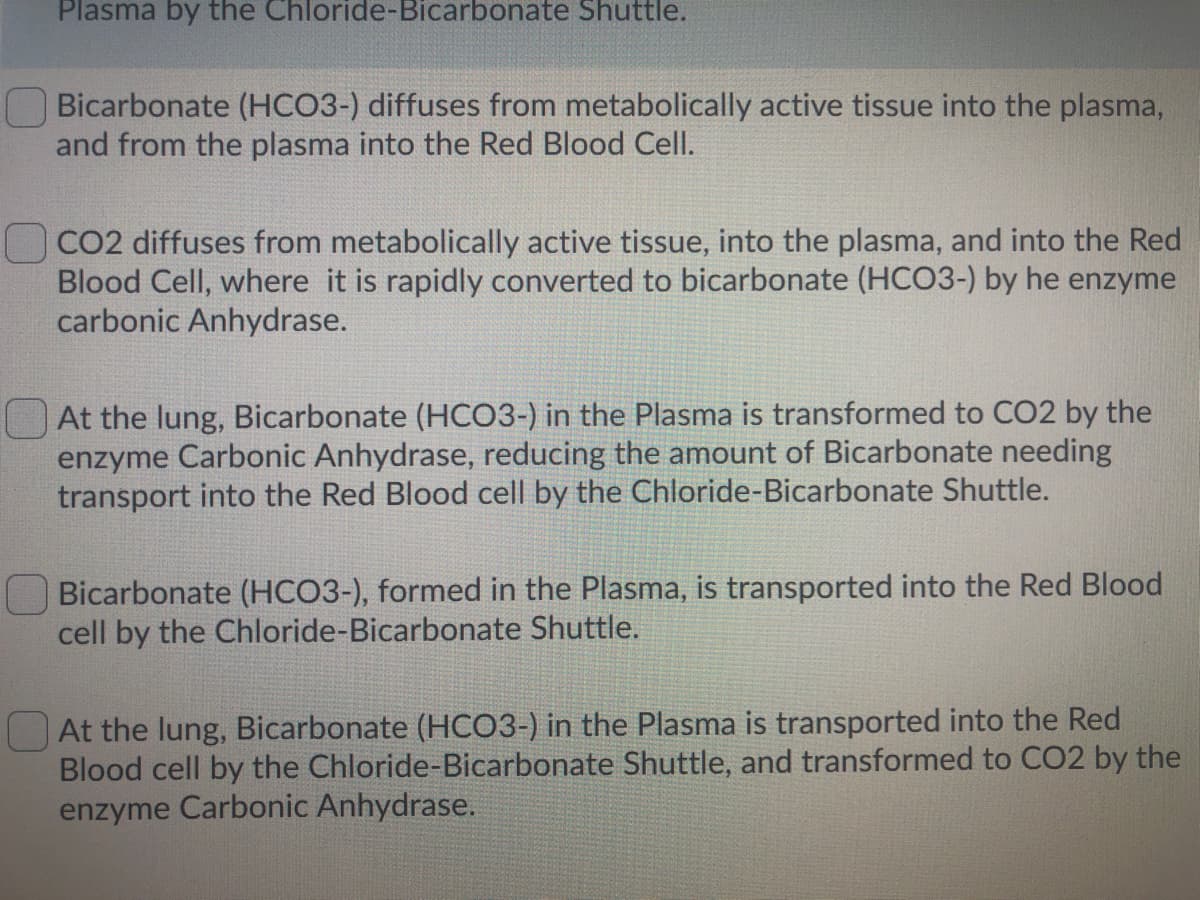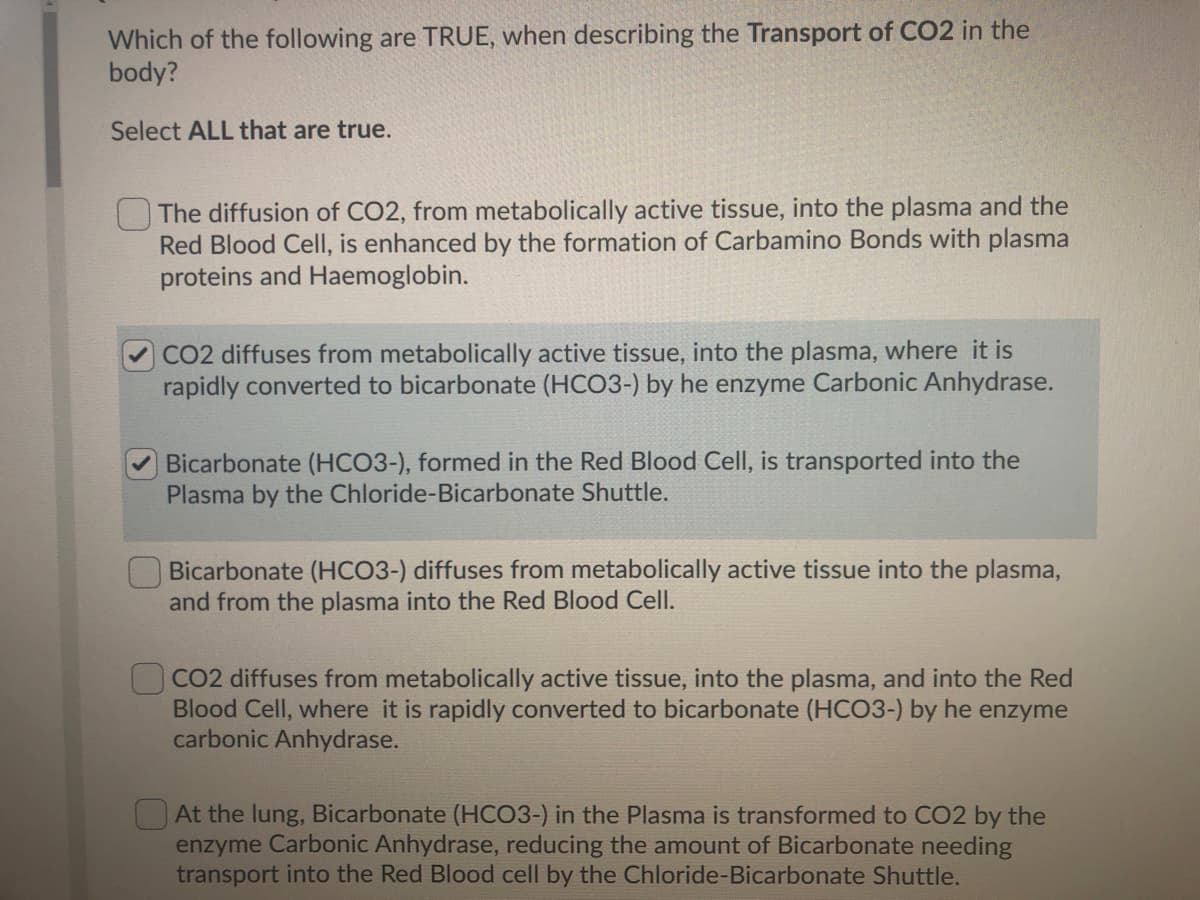Which of the following are TRUE, when describing the Transport of CO2 in the body? Select ALL that are true. The diffusion of CO2, from metabolically active tissue, into the plasma and the Red Blood Cell, is enhanced by the formation of Carbamino Bonds with plasma proteins and Haemoglobin. CO2 diffuses from metabolically active tissue, into the plasma, where it is rapidly converted to bicarbonate (HCO3-) by he enzyme Carbonic Anhydrase. Bicarbonate (HCO3-), formed in the Red Blood Cell, is transported into the Plasma by the Chloride-Bicarbonate Shuttle. Bicarbonate (HCO3-) diffuses from metabolically active tissue into the plasma, and from the plasma into the Red Blood Cell. CO2 diffuses from metabolically active tissue, into the plasma, and into the Red Blood Cell, where it is rapidly converted to bicarbonate (HCO3-) by he enzyme carbonic Anhydrase. O At the lung, Bicarbonate (HCO3-) in the Plasma is transformed to CO2 by the enzyme Carbonic Anhydrase, reducing the amount of Bicarbonate needing transport into the Red Blood cell by the Chloride-Bicarbonate Shuttle.
Which of the following are TRUE, when describing the Transport of CO2 in the body? Select ALL that are true. The diffusion of CO2, from metabolically active tissue, into the plasma and the Red Blood Cell, is enhanced by the formation of Carbamino Bonds with plasma proteins and Haemoglobin. CO2 diffuses from metabolically active tissue, into the plasma, where it is rapidly converted to bicarbonate (HCO3-) by he enzyme Carbonic Anhydrase. Bicarbonate (HCO3-), formed in the Red Blood Cell, is transported into the Plasma by the Chloride-Bicarbonate Shuttle. Bicarbonate (HCO3-) diffuses from metabolically active tissue into the plasma, and from the plasma into the Red Blood Cell. CO2 diffuses from metabolically active tissue, into the plasma, and into the Red Blood Cell, where it is rapidly converted to bicarbonate (HCO3-) by he enzyme carbonic Anhydrase. O At the lung, Bicarbonate (HCO3-) in the Plasma is transformed to CO2 by the enzyme Carbonic Anhydrase, reducing the amount of Bicarbonate needing transport into the Red Blood cell by the Chloride-Bicarbonate Shuttle.
Human Physiology: From Cells to Systems (MindTap Course List)
9th Edition
ISBN:9781285866932
Author:Lauralee Sherwood
Publisher:Lauralee Sherwood
Chapter13: The Respiratory System
Section: Chapter Questions
Problem 15RE
Related questions
Question

Transcribed Image Text:Plasma by the Chloride-Bicarbonate Shuttle.
Bicarbonate (HCO3-) diffuses from metabolically active tissue into the plasma,
and from the plasma into the Red Blood Cell.
CO2 diffuses from metabolically active tissue, into the plasma, and into the Red
Blood Cell, where it is rapidly converted to bicarbonate (HCO3-) by he enzyme
carbonic Anhydrase.
At the lung, Bicarbonate (HCO3-) in the Plasma is transformed to CO2 by the
enzyme Carbonic Anhydrase, reducing the amount of Bicarbonate needing
transport into the Red Blood cell by the Chloride-Bicarbonate Shuttle.
Bicarbonate (HCO3-), formed in the Plasma, is transported into the Red Blood
cell by the Chloride-Bicarbonate Shuttle.
At the lung, Bicarbonate (HCO3-) in the Plasma is transported into the Red
Blood cell by the Chloride-Bicarbonate Shuttle, and transformed to CO2 by the
enzyme Carbonic Anhydrase.

Transcribed Image Text:Which of the following are TRUE, when describing the Transport of CO2 in the
body?
Select ALL that are true.
The diffusion of CO2, from metabolically active tissue, into the plasma and the
Red Blood Cell, is enhanced by the formation of Carbamino Bonds with plasma
proteins and Haemoglobin.
CO2 diffuses from metabolically active tissue, into the plasma, where it is
rapidly converted to bicarbonate (HCO3-) by he enzyme Carbonic Anhydrase.
Bicarbonate (HCO3-), formed in the Red Blood Cell, is transported into the
Plasma by the Chloride-Bicarbonate Shuttle.
Bicarbonate (HCO3-) diffuses from metabolically active tissue into the plasma,
and from the plasma into the Red Blood Cell.
CO2 diffuses from metabolically active tissue, into the plasma, and into the Red
Blood Cell, where it is rapidly converted to bicarbonate (HCO3-) by he enzyme
carbonic Anhydrase.
O At the lung, Bicarbonate (HCO3-) in the Plasma is transformed to CO2 by the
enzyme Carbonic Anhydrase, reducing the amount of Bicarbonate needing
transport into the Red Blood cell by the Chloride-Bicarbonate Shuttle.
Expert Solution
This question has been solved!
Explore an expertly crafted, step-by-step solution for a thorough understanding of key concepts.
This is a popular solution!
Trending now
This is a popular solution!
Step by step
Solved in 3 steps with 2 images

Knowledge Booster
Learn more about
Need a deep-dive on the concept behind this application? Look no further. Learn more about this topic, biology and related others by exploring similar questions and additional content below.Recommended textbooks for you

Human Physiology: From Cells to Systems (MindTap …
Biology
ISBN:
9781285866932
Author:
Lauralee Sherwood
Publisher:
Cengage Learning

Human Biology (MindTap Course List)
Biology
ISBN:
9781305112100
Author:
Cecie Starr, Beverly McMillan
Publisher:
Cengage Learning

Human Physiology: From Cells to Systems (MindTap …
Biology
ISBN:
9781285866932
Author:
Lauralee Sherwood
Publisher:
Cengage Learning

Human Biology (MindTap Course List)
Biology
ISBN:
9781305112100
Author:
Cecie Starr, Beverly McMillan
Publisher:
Cengage Learning